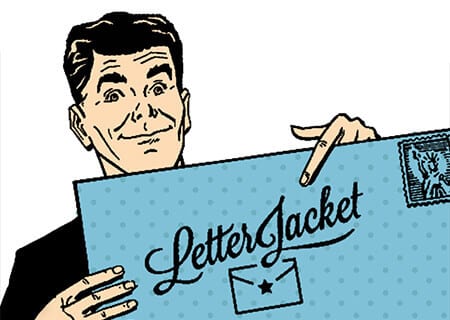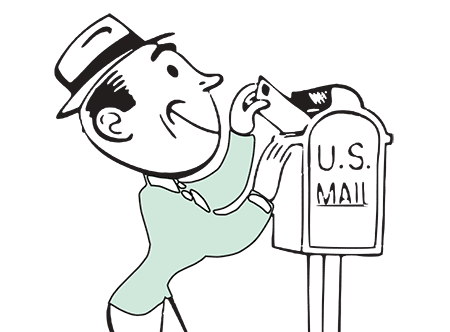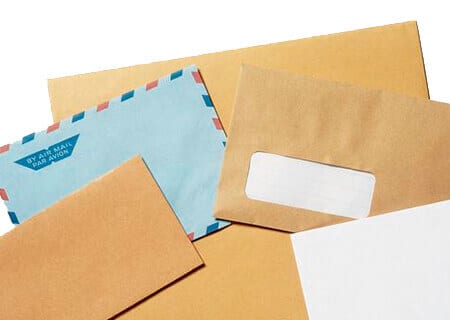Envelope storage is crucial for maintaining your custom-printed envelopes’ look, feel, and functionality. Without proper care, envelopes can yellow, warp, or lose adhesive strength.
In this guide, we’ll answer common questions about envelope storage and share practical tips to keep your supply fresh, professional, and ready to use.
Why Do Envelopes Turn Yellow?
Envelopes turn yellow due to natural chemical reactions in the paper fibers. Over time, exposure to light, heat, and humidity accelerates oxidation, causing paper to darken or discolor. Certain types of paper, like acidic paper or even adhesives, can also speed up the yellowing process.
For example, envelopes made from lower-quality paper or rubber-based adhesives are more prone to discoloration. Over time, yellowing can make your correspondence look aged or unprofessional. Investing in custom-printed envelopes with your logo and branding also means having a plan for their storage when not in use.
According to the University of Chicago Library, storing paper in a cool, dry, and dark environment is the most effective way to prevent yellowing.
Why Do Envelopes Turn Yellow?
Envelopes turn yellow because paper naturally oxidizes when exposed to light, heat, and moisture. Acidic paper and certain adhesives can accelerate discoloration. To prevent yellowing, store envelopes in a cool, dry, and dark environment, keep them in their original packaging, and avoid direct sunlight or high humidity.
How Can You Store Envelopes to Prevent Damage?
Proper envelope storage is essential for both appearance and function. Best practices include:
- Store envelopes in a cool, dry place – Avoid basements or attics where temperature and humidity change throughout the year.
- Keep them in their original packaging – this protects them from dust, light, air, and possible fingerprints or spills.
- Avoid direct sunlight – UV light can accelerate yellowing and weaken paper fibers.
- Stack neatly and flat – Prevents bending, curling, or creasing.
- Use a dedicated storage container – A plastic bin or drawer designed for paper can reduce dust and accidental spills.
For more tips, see our best practices for storing and caring for envelopes.
How Can You Keep Envelopes From Bending or Warping?
Paper products are sensitive to environmental changes. To keep envelopes straight and professional-looking:
- Use a flat storage bin or drawer to support the weight evenly.
- Don’t over-stack – heavy piles can crease or curl envelopes at the bottom.
- Rotate inventory – use older envelopes first to prevent long-term storage issues.
- Avoid placing heavy objects on top – Even slight pressure from stacked items can create permanent bends.
These steps are particularly important for custom-printed envelopes, where bending can affect the printed design or adhesive flap alignment.
Why Does Envelope Adhesive Stop Working?
Envelope adhesives—especially moisture-activated ones—can dry out or become sticky when stored improperly. Heat and humidity break down the glue, while dry air makes it brittle.
The Museum Library at the University of Illinois notes that adhesives often deteriorate faster than the paper itself, making storage conditions critical.
Tip: Always store envelopes in sealed packaging until ready for use to protect the adhesive and prevent premature sticking or brittleness.
What Is the Best Way to Store Large Quantities of Envelopes?
If your office or organization orders envelopes in bulk, here’s how to keep them in top condition:
- Use climate-controlled storage. Avoid garages or sheds where temperatures fluctuate.
- Keep cartons off the floor. Use pallets or shelves to protect against moisture.
- Limit exposure. Open one carton at a time instead of multiple to prevent dust and light damage.
- Label storage boxes. Mark with your purchase date to track usage and rotate supplies.
- Consider archival sleeves for special envelopes. Use special products for holidays or certain clients? Archival sleeves are an excellent option for these.
FAQ: Common Envelope Storage Questions
Q: Do envelopes expire?
A: While paper doesn’t necessarily “expire,” adhesive and quality can degrade over time and with specific exposures. Proper envelope storage can make them last for years.
Q: Can colored envelopes yellow faster?
A: Yes, envelopes with dyes or printing may show discoloration sooner if exposed to sunlight or heat. Store in a dark, cool environment.
Q: How long can adhesives last in storage?
A: Moisture-activated adhesives generally remain reliable for 1–2 years if stored correctly, but extreme heat, humidity, or dryness shortens their lifespan.
How Does Proper Envelope Storage Benefit Businesses?
For businesses, schools, and nonprofits, envelopes are more than stationery. They are an investment in resources and brand.
They carry branding, professionalism, and communication. Damaged or discolored envelopes can send the wrong message. Proper storage ensures:
- Professional presentation with clean, crisp envelopes.
- Longer shelf life, reducing waste, and replacement costs.
- Reliable performance, with adhesives and seals working as intended.
- The integrity of custom-printed logos, colors, or design features.
Why does protecting my envelopes matter?
Proper envelope storage isn’t just about protecting paper. It is about protecting your investment in professional communication. At Letter Jacket, we provide high-quality, custom-printed envelopes designed to make a lasting impression. Pairing durable printing with smart storage ensures your envelopes always look their best.
Ready to order custom envelopes that reflect your brand? Contact us today to get started.
Key Takeaways: How to Store Envelopes Properly
- Envelope storage matters: Protects against yellowing, bending, and adhesive failure.
- Keep envelopes in a cool, dry, dark place to slow oxidation and preserve paper quality.
- Original packaging helps: Leave envelopes sealed until ready to use.
- Store flat and rotate stock for best results in bulk storage.
Good storage saves money by extending the life of custom-printed envelopes.



